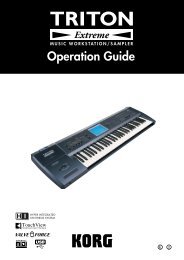Line 6 POD Studio & TonePort MIDI Setup Guide ... - zZounds.com
Line 6 POD Studio & TonePort MIDI Setup Guide ... - zZounds.com
Line 6 POD Studio & TonePort MIDI Setup Guide ... - zZounds.com
You also want an ePaper? Increase the reach of your titles
YUMPU automatically turns print PDFs into web optimized ePapers that Google loves.
5•5<br />
<strong>MIDI</strong> <strong>Setup</strong> <strong>Guide</strong>: Controlling <strong>POD</strong> Farm 2<br />
To configure your DAW application to receive <strong>MIDI</strong> input, the settings are usually found in the<br />
applications’ Preferences or Options menus. Please refer to “Ableton Live <strong>MIDI</strong> Input Device<br />
Configuration” on page 3•1 for an example. The steps are similar in most DAW applications.<br />
The next step is to route the <strong>MIDI</strong> control data from your UX2/UX8/KB37 device to feed it to the<br />
audio track where <strong>POD</strong> Farm 2 Plug-In is inserted. This is typically ac<strong>com</strong>plished by setting up a<br />
<strong>MIDI</strong> track to receive from your <strong>MIDI</strong> device, and the track’s Output to the audio track & Plug-In.<br />
For example, here is how to configure this in Ableton Live, where <strong>POD</strong> Farm 2 Plug-In is inserted on<br />
Audio track 1.<br />
<strong>POD</strong> Farm 2 Plug-In is inserted<br />
on Audio track 1<br />
On a new <strong>MIDI</strong> track, set the Input to your <strong>POD</strong><br />
<strong>Studio</strong>/<strong>TonePort</strong> device<br />
Set the Output to be the Audio track where your<br />
<strong>POD</strong> Farm 2 Plug-In is inserted<br />
The <strong>POD</strong> Farm 2 Plug-In should then appear as the<br />
“<strong>MIDI</strong> Output Channel” destination<br />
Configuring Ableton Live for <strong>MIDI</strong> Input to <strong>POD</strong> Farm 2 Plug-In<br />
Be sure to Arm the <strong>MIDI</strong> track<br />
to allow <strong>MIDI</strong> throughput<br />
Once this <strong>MIDI</strong> routing is <strong>com</strong>pleted, you should be able to instantly access the <strong>POD</strong> Farm 2 Plug-In<br />
Tone Presets’ “pre-configured” <strong>MIDI</strong> assignments and control, as covered on page 5•1. To create your own<br />
<strong>MIDI</strong> control assignments, you can also utilize the <strong>POD</strong> Farm 2 <strong>MIDI</strong> Learn feature - as we’ll cover in<br />
the next section!<br />
<strong>POD</strong> Farm 2 Plug-In <strong>MIDI</strong> Learn<br />
The <strong>POD</strong> Farm 2 Plug-In <strong>MIDI</strong> Learn feature allows you to easily “map” your <strong>POD</strong> <strong>Studio</strong>/<strong>TonePort</strong><br />
device’s footswitch, pedal, knob, button and pitch wheel controllers to practically any <strong>POD</strong> Farm 2<br />
parameter for remote control. To follow are the steps:<br />
• In the <strong>POD</strong> Farm 2 Plug-In window, double click on any model in the Signal Flow View to load<br />
its Edit Panel in the Panel View. Right click (Windows ® ) or Ctrl+click (Mac ® ) directly on the<br />
model’s knob, slider or switch that you want to control remotely and select the <strong>MIDI</strong> Control<br />
menu. For example, load a Delay effect model and then right click/Ctrl+click directly on the<br />
Delay’s Mix knob within the Panel View to assign this parameter.<br />
• In the <strong>MIDI</strong> Control sub-menu, click <strong>MIDI</strong> Learn. This places <strong>POD</strong> Farm 2 into <strong>MIDI</strong> Learn<br />
mode, where it waits to receive a <strong>com</strong>mand from your connected <strong>MIDI</strong> Control device.<br />
Right click (Windows®) or Ctrl+click<br />
(Mac®) directly on the desired control<br />
(Delay-Mix knob, in this example)<br />
Select <strong>MIDI</strong> Learn to place <strong>POD</strong> Farm 2<br />
Plug-In in <strong>MIDI</strong> Learn mode

















